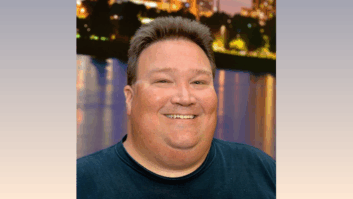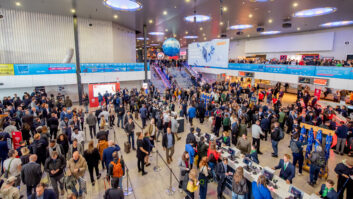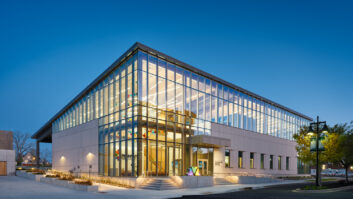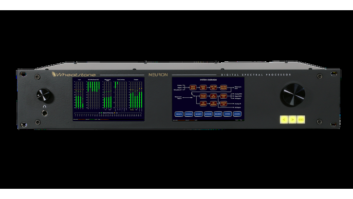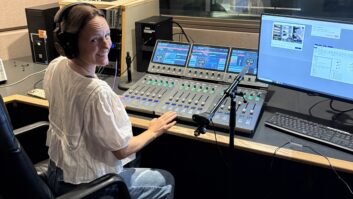Changes were overdue at All Classical Portland when Jack Allen arrived in mid-2008, hired by the board of nonprofit, listener-supported 89.9 KQAC(FM).
The president and CEO of the public station said, “When I got here, I pulled the BBC news, jettisoned nationally-syndicated [legacy] programming like ‘Pipedreams,’ ‘From the Top’ and ‘St. Paul Sunday’ and initiated development of rich, local content.”

Suzanne Nance in “The Observatory” at All Classical Portland These additions included “The Score,” a now-syndicated show featuring symphonic movie soundtracks and their composers; and “On Deck With Young Musicians,” clearly an Allen favorite. “It’s killer. I love it!” Could those “Young Musicians” be part of a future bench of Portland talent? “Why not?”
Allen also persuaded his board it was time to move out of their cozy digs at Portland’s Benson Polytechnic High School into something larger — like the 12,800 sq. ft. former television station in a waterfront building owned by their cultural arts partner, the Portland Opera. He believed that world-class facilities combined with Portland’s appealing well-educated and youthful demographics could help attract scarce on-air talent who shared his vision.
The remodeling ran $2.5 million (they moved in mid-2014) while All Classical’s yearly budget for the facility and staff of 23 is $3.5 million, 93 percent of which is paid by listeners, most of whom are in the local community.
All Classical Portland Vice President of Technology Larry Holtz laid out some of the move. “In our previous studio building we converted to Axia consoles, so we brought that equipment and expanded in the new building.”
He explained: “The on-air studio uses three Axia Element control surfaces — 12 channels to the left of the announcer, 12 channels to the right, providing a center area for mice, keyboards and paper copy. The third four-channel Axia Element is for the co-host. In our large performance control room is a 24-channel Element. The other studios have 12-channel Axia Radius consoles, including two office/studio rooms with the consoles on Ergotron swing arms.” Feeding the lot is an array of Axia XNodes for distribution audio and control along with an Axia studio intercom system.
NEW BLOOD
Allen had his ears on Suzanne Nance for years via online streaming as she moved through the on-air, radio programming and TV production ranks at Maine Public Broadcasting Network and Chicago’s WFMT Network. She started her career at WHYY Philadelphia.
He made his pitch to Nance in mid-2015, flying her out to Portland for the talk-and-tour. “Here’s our philosophy of community service, our vision for the future … and by the way, Suzanne, here’s your stunning new studio. Do you like the view?” The new main studio is perched overlooking the Willamette River, nicknamed “The Observatory.”
Nance joined All Classical Portland in September 2015 as program director.
She hosts the four-hour afternoon drive-time program at All Classical from what is best described as a ship’s bridge. Nance commands a 12-foot-wide custom granite production table that rotates 359 degrees, with a panoramic view of Tilikum Crossing, the Willamette River and an awesome Portland skyline. A live “Tili-Cam” captures Nance’s unique view of the river and skyline, as well as an audio feed for an increasingly important online and mobile audience.
KQAC EQUIPMENT
All Classical Portland’s Vice President of Technology Larry Holtz provided the following list of equipment used at the station.
Announcer microphones: DPA4066-B condenser headset mic
Mic processors: Wheatstone Vorsis M2
Headphones: Sony MDR7506
Audio consoles: Axia Element and Axia Radius
Studio furniture: Custom 359-degree rotating control room desk, Forecast Freeform Shaped Sit with elevation motor in production studios
Studio lighting: Dimmable LED strip lighting and ceiling fixtures
Additional lights: MIKA Litt
Studio doors and windows: IAC
Record and playout system: ENCO DAD running on an Axia Livewire network
Audio distribution: Axia Livewire XNodes — AES, analog, mic and GPIO
Studio monitoring: KRK Systems VXT-6, KRK12S subwoofers
Studio telephones: Axia VS system with VSet6 phones
Clocks: ESE ES-185U GPS master clock/NTP time server, BRG Precision POE digital and analog clocks
EAS: Sage Digital ENDEC with Digital Alert Systems R198 four-unit AES switch
Studio remote control: Davicom MicroMAC
Studio & technical operations center UPS: APC Symmetra SY80K80F 80 KVA three-phase
Technical operations center racks: Middle Atlantic WMRK-4548
Technical operations center rack power distribution: APC AP-7930 PDU, IP control per individual outlet
Technical operations center Ethernet switching: Cisco WS-C3750X stacked 1G core switches, Netgear GS748TP 10G edge switches, CAT-6A shielded cabling
Streaming services: Custom servers running Orban Opticodec-PC with Optimod-PC 1101 audio cards
Audio logging: Axia iProfiler
Audio and data storage and backup: Dell iSCSI servers with various QNAP TS-EC1679 RAID10 NAS
RDS and HDText: Broadcast Electronics TRE software on custom server
STL: 11 GHz and 18 GHz Cambium PTP-800 radios with dual-pol antennas transporting uncompressed AOIP
STL audio transport: APT IP codecs with SureStream technology
It’s quite a performance, as Nance, also a singer, obviously relishes the stage. She’s turned-out impeccably, gliding smoothly along the table, leaning in like a conductor, gesturing passionately to an unseen audience, tweaking the Axia Radius’ faders, her eye on the waveforms. Nance is unencumbered by a traditional boom-mounted mic, preferring the freedom of a DPA 4066-B omnidirectional headset microphone favored by musical theater talent.
The studio signal is processed by a Wheatstone Vorsis M2 dual voice processor. Holtz says of the unit, “The M2 provides intelligent multi-band compression designed specifically for microphones, producing consistent equalization for all our announcers, greatly reducing issues with boominess and excessive sibilance.”
Holtz says that All Classical Portland isn’t done, yet: “We just completed building our final studio, Production B. Our goal for the upcoming fiscal year is to focus improving our backup and redundancy of all systems. Yes, like most stations, we have pretty good backups, but we’re bringing it to the next level with more auto failover of Internet WAN, broadcast automation, and so many systems at our six terrestrial broadcast transmitter plants. In the studio building, we’re augmenting our stage lighting, microphones and acoustical treatment in our live performance studio.”
Allen knows that All Classical Portland can’t sit still. Change is constant and people move on. Unlike sports teams, there’s typically no “bench” of radio talent who have trained with the station’s stars. Oh, sure, someone can always fill-in but that doesn’t solve the bigger long-term problem, especially in a tough niche like classical. Allen is determined to avoid that eventuality with a plan — actually, several big plans, for developing, hiring and mentoring new talent, leadership and management succession, plus adding an HD2 and Internet channel as a designated sandbox, laboratory and boot camp.
Tracking and wooing talent, not just from radio, has been a consistent pattern in Allen’s career. “At KMFA(FM) in Austin [2003–2008], I hired a New York Times writer, with no previous radio experience but smart as a whip, authentic voice and a person who really connected with the audience,” said Allen. “I wooed a jazz DJ from Austin’s KUT(FM), an amazing singer-songwriter who loved classical,” added Allen. “She had a niche role at KUT. At KMFA she became what we call the anchor voice at that station; and she’s still holding down the midday slot.”
He plans to do more of the same in Portland. Allen’s succession strategy plans are clearly moving forward, and include Nance, who is scheduled to become vice president of programming, eventually replacing John Burk, who currently follows her as host in the early-evening program slot. Nance also mentors colleagues at other stations and is on all the Facebook classical chats.
In Allen’s office an ancient Ampex reel-to-reel machine sits next to an even older instrument, his chess set.
“The chess game is not only about the next move, but about the exponential variations that go forward,” Allen reflected. “When you stretch the brain, the strategy and vision muscles involved with high level chess, it starts to apply to everything. The challenge at All Classical Portland is to reverse engineer the big dream to what we’re going to do today. It gives a sense of security to those who work here because they know we’ve got a game plan, that they are valued and have a role in the future we all want. Our team is about long-term strategy, necessarily, but willing to make short-term tactical adjustments to the plan, as needed.”
Christopher Springmann is chief storytelling officer forwww.onthepathproductions.com.



